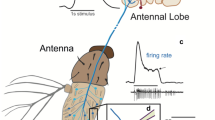Abstract
This paper presents a model of a network of integrate-and-fire neurons with time delay weights, capable of invariant spatio-temporal pattern recognition. Spatio-temporal patterns are formed by spikes according to the encoding principle that the phase shifts of the spikes encode the input stimulus intensity which corresponds to the concentration of constituent molecules of an odor. We applied the Hopfield's phase shift encoding principle at the output level for spatio-temporal pattern recognition: Firing of an output neuron indicates that corresponding odor is recognized and phase shift of its firing encodes the concentration of the recognized odor. The temporal structure of the model provides the base for the modeling of higher level tasks, where temporal correlation is involved, such as feature binding and segmentation, object recognition, etc.
Similar content being viewed by others
References
Campbell, S. and Wang, D.: Synchrony and desynchrony in integrate-and-fire oscillators. Proceedings of the IEEE International Joint Conference on Neural Networks, Anchorage, Alaska, 2 (1998), 1498–1503.
Duchamp-Viret, P. and Palouzier-Paulignan, B. and Duchamp A.: Sensory information processing in the frog olfactory pathways. Experimental basis for modeling studies. Biosystems, 48 (1998), 37–45.
Duchamp-Viret, P. and Palouzier-Paulignan, B. and Duchamp A.: Odor coding properties of frog olfactory cortical neurons. Neuroscience, 74 (1996), 885–895.
Hopfield J.: Pattern recognition computation using action potential timing stimulus representation. Nature, 376 (1995), 33–36.
Hoshino, O. and Kashimori, Y. and Kambara, T.: An olfactory recognition model based on spatio-temporal encoding of odor quality in the olfactory bulb. Biological Cybernetics, 79 (1998), 109–120.
Jinks, A. and Laing, D.: Temporal processing reveals a mechanism for limiting the capacity of humans to analyze odor mixtures. Cognitive Brain Research, 8 (1999), 311–325.
Laurent, G. and Davidowitz, H.: Encoding of olfactory information with oscillating neural assemblies. Science, 265 (1994), 1872–1875.
Laurent G.: Dynamical representation of odors by oscillating and evolving neural assemblies. Trends in Neuroscience, 19 (1996), 489–496.
Malsburg, C. von der, Buhmann,J.: Sensory segmentation with coupled neural oscillators. Biological Cybernetics, 67 (1992), 233–242.
Malsburg, C. von der, Schneider W.: A neural cocktail-party processor. Biological Cybernetics, 54 (1986), 29–40.
Natschlager, T. and Ruf, R.: Spatial and temporal pattern analysis via spiking neurons. Network, 9(3) (1998), 319–332.
Ressler, K. and Sullivan, S. and Buck,L.: Information coding in the olfactory system: evidence for a stereotyped and highly organized epitope map in the olfactory bulb. Cell, 79 (1994), 1245–1255.
Skarda,C. and Freeman, W.: How brains make chaos in order to make sense of the world. Behavioral and Brain Sciences, 10 (1987), 161–195.
White, J. and Dickinson, T. and Walt, D. and Kauer,J.: An olfactory neuronal network for vapor recognition in an artificial nose. Biological Cybernetics, 78 (1998), 245–251.
Author information
Authors and Affiliations
Rights and permissions
About this article
Cite this article
Lysetskiy, M., Lozowski, A. & Zurada, J.M. Invariant Recognition of Spatio-Temporal Patterns in The Olfactory System Model. Neural Processing Letters 15, 225–234 (2002). https://doi.org/10.1023/A:1015773115997
Issue Date:
DOI: https://doi.org/10.1023/A:1015773115997




